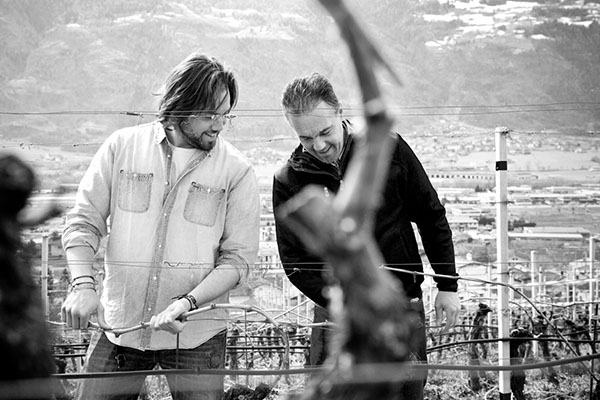From €16, $33.99, £23.50
Deeply depressed by yesterday's vote to leave the EU, I am determined to choose a European wine today to remind us all of the riches available in the world's most important wine-producing economic community. What a shame that it looks likely that we Brits will all have to pay so much more for our wine. Okay, the plummeting pound may make English wine look even more attractive, but the price paid overall (and I don't just mean the price of wine) will surely be heavy.
Today’s wine is seriously individual – and made in such small quantities, just 8,000 bottles a year, that it is rather a miracle that it is possible to buy it in the UK, US and Italy. The Aosta Valley is Italy’s smallest region, way up in the mountains on the way to Switzerland in the far north west. Our co-author of Wine Grapes José Vouillamoz wrote a book in 2011 about the indigenous vine varieties of Aosta so I always associate the region with him, and he of course would much rather I recommended a wine made from a local variety. But the wine I have tasted and am recommending here, recently unearthed by Jason Haynes of Flint Wines, is made from our old friend Pinot Noir. (Flint is best-known for its burgundies.)
When I first tasted it I was rather flummoxed. It tasted nothing like any other Pinot Noir I had encountered. Not the complex majesty of a fine burgundy, nor the immediate fruitiness of a New Zealand version, nor the freshness of one of the increasing number of light-bodied Pinots made the length of the eastern Pacific coastline.

It was rather impressive the way it opened up in the glass – always a good sign in my experience. Pale cherry red, it was obviously ripened in a fair bit of sunshine – and initially seemed very slightly dry in the sense of having thick skins (the picture of Ottin's vines, in spectacular scenery, suggests that irrigation is sometimes needed, though presumably not in the damp growing season of 2014). But this cheery and rewarding wine also had excellent acidity, perhaps in this case the result of being grown at high elevation, and real grip and graininess on the palate (slightly like an Ahr Spätburgunder). I loved the combination of purity and grunt in the wine. The assertive fruit has a certain charming sweet ripeness to it and yet it’s very far from being sickly or syrupy. We finished the bottle over two or three evenings with very varied food and this young, unoaked Pinot seemed to take on all-comers. The alcohol level noted on the label is 13.5%.
The vines from which this wine was made were Burgundy clones planted by the Ottin family in 1989 on their steep, south-facing terraces at around 590 m elevation – very high for Italy. The Ottins continued to deliver their grapes to the local co-op until son Elio (pictured on the right below with his son Nicolas) started his own label in 2007, having taken over management of the small six-hectare wine farm in the early 1990s. Right from the start his wines won acclaim in Italy.

Nowadays the estate is farmed organically and also produces a varietal Fumin, Petit Rouge and a blend of 80% Petit Rouge, 10% Fumin and 10% Cornalin (all local red wine grapes) sold as Torrette Superieur and Petite Arvine (the white wine grape more readily associated with the Valais across the border in Switzerland). Flint are apparently planning to import some of these in September. I look forward to tasting them. (You may also enjoy examples from Les Crêtes, the largest independent wine producer in Aosta – although even they have only 25 ha of vineyards.)
In the UK the Ottin Pinot Noir is available from Stannary Street Wine Co, importer Flint’s retail arm. You may have to call them in order to order by the single bottle. The online offer is for six bottles in bond at £95. On Wednesday, Flint, incidentally, issued this dire warning of white burgundy shortages to come, confirmed yesterday by Jacques Carillon, who was over in London to show a range of his wines:
As you know, due to a severe frost at the end of April in the Côte d'Or and various heavy hailstorms in both Chablis and the Mâconnais, the production of white burgundy in 2016 is going to be tiny. Some growers have lost everything, others are hoping they might be able to produce perhaps half of what they would normally. On the back of several recent small vintages and unprecedented demand for the stunning 2014s this is going to create a big hole in supplies of white burgundy.
We are already fielding various calls from the trade looking to top up any back vintages we may still have available and in another six months we can foresee a real shortage of wine.
For example, save for a handful of cases of village wine earmarked for loyal restaurant customers, we have nothing to offer from established growers such as Alex Moreau in Chassagne (Domaine Bernard Moreau). We have never been in this situation before.
There is a positive element to this crisis though. It has given up-and-coming producers a chance to step into the limelight and get their wines noticed.
With this in mind we would like to highlight a wine from three growers, who have been progressing nicely over the last five years.
They then cite Domaine Tessier's Bourgogne Blanc Champ Perrier 2013 at £19.95 a bottle; Puligny 2013 from Pernot-Belicard at £42 a bottle (16/20); and Chassagne Maltroye 2013 from Heitz-Lochardet (a young producer with some very well-placed vines) at £55 a bottle (17/20).
Among the white burgundy vintages I tasted yesterday, 2013 was the most muted. I would stock up on 2014, 2012 and 2010 if you can.














